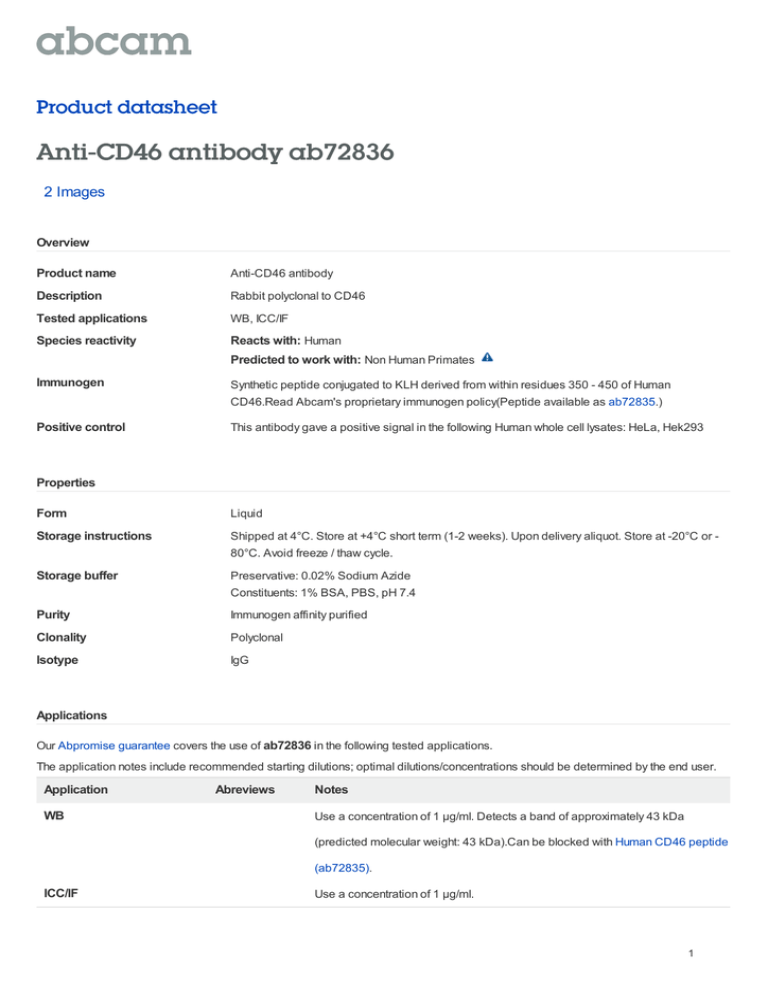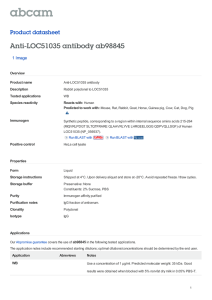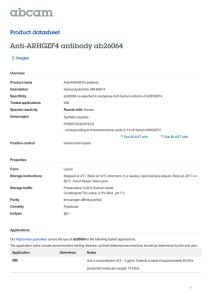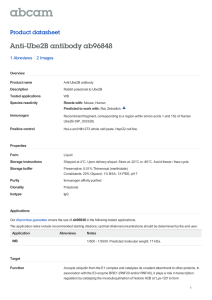Anti-CD46 antibody ab72836 Product datasheet 2 Images
advertisement

Product datasheet Anti-CD46 antibody ab72836 2 Images Overview Product name Anti-CD46 antibody Description Rabbit polyclonal to CD46 Tested applications WB, ICC/IF Species reactivity Reacts with: Human Predicted to work with: Non Human Primates Immunogen Synthetic peptide conjugated to KLH derived from within residues 350 - 450 of Human CD46.Read Abcam's proprietary immunogen policy(Peptide available as ab72835.) Positive control This antibody gave a positive signal in the following Human whole cell lysates: HeLa, Hek293 Properties Form Liquid Storage instructions Shipped at 4°C. Store at +4°C short term (1-2 weeks). Upon delivery aliquot. Store at -20°C or 80°C. Avoid freeze / thaw cycle. Storage buffer Preservative: 0.02% Sodium Azide Constituents: 1% BSA, PBS, pH 7.4 Purity Immunogen affinity purified Clonality Polyclonal Isotype IgG Applications Our Abpromise guarantee covers the use of ab72836 in the following tested applications. The application notes include recommended starting dilutions; optimal dilutions/concentrations should be determined by the end user. Application WB Abreviews Notes Use a concentration of 1 µg/ml. Detects a band of approximately 43 kDa (predicted molecular weight: 43 kDa).Can be blocked with Human CD46 peptide (ab72835). ICC/IF Use a concentration of 1 µg/ml. 1 Target Function Acts as a cofactor for complement factor I, a serine protease which protects autologous cells against complement-mediated injury by cleaving C3b and C4b deposited on host tissue. May be involved in the fusion of the spermatozoa with the oocyte during fertilization. Also acts as a costimulatory factor for T-cells which induces the differentiation of CD4+ into T-regulatory 1 cells. T-regulatory 1 cells suppress immune responses by secreting interleukin-10, and therefore are thought to prevent autoimmunity. A number of viral and bacterial pathogens seem to exploit this property and directly induce an immunosuppressive phenotype in T-cells by binding to CD46. Tissue specificity Expressed by all cells except erythrocytes. Involvement in disease Defects in CD46 are a cause of susceptibility to hemolytic uremic syndrome atypical type 2 (AHUS2) [MIM:612922]. An atypical form of hemolytic uremic syndrome. It is a complex genetic disease characterized by microangiopathic hemolytic anemia, thrombocytopenia, renal failure and absence of episodes of enterocolitis and diarrhea. In contrast to typical hemolytic uremic syndrome, atypical forms have a poorer prognosis, with higher death rates and frequent progression to end-stage renal disease. Note=Susceptibility to the development of atypical hemolytic uremic syndrome can be conferred by mutations in various components of or regulatory factors in the complement cascade system. Other genes may play a role in modifying the phenotype. Patients with CD46 mutations seem to have an overall better prognosis compared to patients carrying CFH mutations. Sequence similarities Contains 4 Sushi (CCP/SCR) domains. Domain Sushi domains 1 and 2 are required for interaction with human adenovirus B PIV/FIBER protein and with Measles virus H protein. Sushi domains 2 and 3 are required for Herpesvirus 6 binding. Sushi domain 3 is required for Neisseria binding. Sushi domains 3 and 4 are required for interaction with Streptococcus pyogenes M protein and are the most important for interaction with C3b and C4b. Post-translational modifications N-glycosylated on Asn-83; Asn-114 and Asn-273 in most tissues, but probably less Nglycosylated in testis. N-glycosylation on Asn-114 and Asn-273 is required for cytoprotective function. N-glycosylation on Asn-114 is required for Measles virus binding. N-glycosylation on Asn-273 is required for Neisseria binding. N-glycosylation is not required for human adenovirus binding. Extensively O-glycosylated in the Ser/Thr-rich domain. O-glycosylation is required for Neisseria binding but not for Measles virus or human adenovirus binding. In epithelial cells, isoforms B/D/F/H/J/L/3 are phosphorylated by YES1 in response to infection by Neisseria gonorrhoeae; which promotes infectivity. In T-cells, these isoforms may be phosphorylated by Lck. Cellular localization Cytoplasmic vesicle > secretory vesicle > acrosome inner membrane. Inner acrosomal membrane of spermatozoa. Internalized upon binding of Measles virus, Herpesvirus 6 or Neisseria gonorrhoeae, which results in an increased susceptibility of infected cells to complement-mediated injury. In cancer cells or cells infected by Neisseria, shedding leads to a soluble peptide. Anti-CD46 antibody images 2 All lanes : Anti-CD46 antibody (ab72836) at 1 µg/ml Lane 1 : HeLa (Human epithelial carcinoma cell line) Whole Cell Lysate Lane 2 : HEK293 (Human embryonic kidney cell line) Whole Cell Lysate Lysates/proteins at 10 µg per lane. Secondary Western blot - Anti-CD46 antibody (ab72836) Goat Anti-Rabbit IgG H&L (HRP) (ab97051) at 1/10000 dilution developed using the ECL technique Performed under reducing conditions. Predicted band size : 43 kDa Observed band size : 50 kDa Additional bands at : 100 kDa,37 kDa. We are unsure as to the identity of these extra bands. Exposure time : 150 seconds ICC/IF image of ab72836 stained HeLa cells. The cells were 4% PFA fixed (10 min) and then incubated in 1%BSA / 10% normal goat serum / 0.3M glycine in 0.1% PBS-Tween for 1h to permeabilise the cells and block nonspecific protein-protein interactions. The cells were then incubated with the antibody (ab78236, 1µg/ml) overnight at +4°C. The secondary antibody (green) was Alexa Fluor® Immunocytochemistry/ Immunofluorescence - 488 goat anti-rabbit IgG (H+L) used at a CD46 antibody (ab72836) 1/1000 dilution for 1h. Alexa Fluor® 594 WGA was used to label plasma membranes (red) at a 1/200 dilution for 1h. DAPI was used to stain the cell nuclei (blue) at a concentration of 1.43µM. This antibody also gave a positive result in 4% PFA fixed (10 min) Hek293, HepG2 and MCF7 cells at 1µg/ml, and in 100% methanol fixed (5 min) Hela, hek293, HepG2 and MCF7 cells at 1µg/ml. Please note: All products are "FOR RESEARCH USE ONLY AND ARE NOT INTENDED FOR DIAGNOSTIC OR THERAPEUTIC USE" 3 Our Abpromise to you: Quality guaranteed and expert technical support Replacement or refund for products not performing as stated on the datasheet Valid for 12 months from date of delivery Response to your inquiry within 24 hours We provide support in Chinese, English, French, German, Japanese and Spanish Extensive multi-media technical resources to help you We investigate all quality concerns to ensure our products perform to the highest standards If the product does not perform as described on this datasheet, we will offer a refund or replacement. For full details of the Abpromise, please visit http://www.abcam.com/abpromise or contact our technical team. Terms and conditions Guarantee only valid for products bought direct from Abcam or one of our authorized distributors 4
![Anti-CD46 antibody [MEM-258] (Allophycocyanin) ab60904](http://s2.studylib.net/store/data/012458907_1-a7c4f547b462bafb21d980d01ed17e08-300x300.png)




![Anti-CD46 antibody [EPR4014] (Alexa Fluor® 488) ab197489](http://s2.studylib.net/store/data/012458903_1-cb28e5f61a8df10aa62fcd526b86df12-300x300.png)